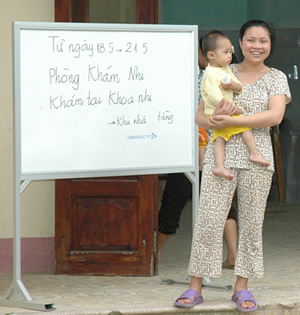Protecting Infants From HIV
New WHO Recommendations for Pregnant Women
February 2010—HIV/AIDS is the leading cause of death worldwide among women of reproductive age. The proportion of HIV-positive women who received antiretroviral therapy (ART) or prophylaxis to prevent HIV transmission to their infants rose from 33 percent in 2007 to 45 percent in 2008.1
Despite this improvement, around 430,000 children were born with HIV in 2008, and the number of women living with HIV is steadily increasing. In Asia, women now represent 35 percent of all people living with HIV.1

Mother and child outside the Lao Cai Provincial
Hospital No. 1 in Lao Cai, Viet Nam. |
The World Health Organization (WHO) recently released new recommendations on the use of antiretrovirals to prevent mother-to-child transmission.2 The primary goals of the revised approach are to improve maternal health and reduce the risk of mother-to-child transmission to five percent or less. WHO now calls for all patients, including HIV-positive pregnant women, to begin ART when their CD4 counts fall below 350 cells/mm3, or at WHO clinical stages 3 or 4. Starting ART at higher CD4 counts can prevent severe damage to the immune system, reducing the risk of HIV-related health problems and death.
For women who do not need to start ART yet for their own health, WHO has recommended that antiretroviral prophylaxis be started as early as the fourteenth week of pregnancy and continued through the breastfeeding period. This is more aggressive than WHO's 2006 recommendation of treatment at a CD4 count below 200 cells/mm3 and prophylaxis after the twenty-eighth week of pregnancy. It is also the first time WHO has promoted ART for HIV-positive mothers while breastfeeding.
However, implementing these recommendations will present feasibility and cost challenges in order to identify patients at higher CD4 counts and provide them with access to a broader range of antiretroviral options. In addition, while the global average for coverage of maternal antiretrovirals for preventing mother-to-child transmission in low- and middle-income countries is now 45 percent, in Asia it is still only 25 percent.1 Despite other HIV treatment successes in the region, the low scale-up of these services continues to be a challenge.
For specific recommendations on antiretroviral regimens for women and infants, please see
http://www.who.int/hiv/pub/mtct/advice/en/.
1 UNAIDS and WHO. AIDS Epidemic Update. November 2009; Geneva: UNAIDS.
2 WHO. Rapid Advice: Use of antiretroviral drugs for treating pregnant women and preventing HIV infection in infants. November 2009; Geneva: WHO. The final revised guidelines are scheduled for release later in 2010.